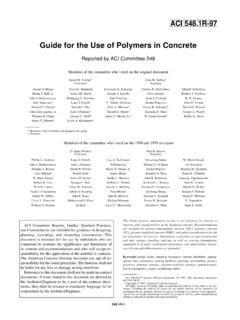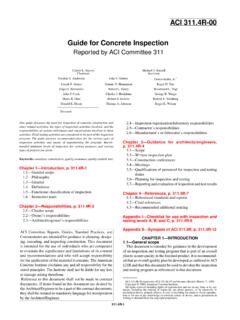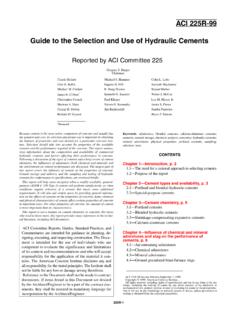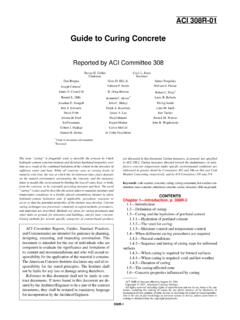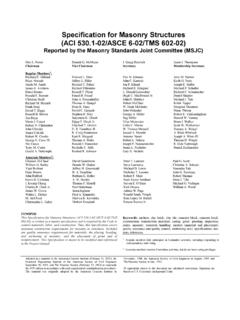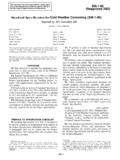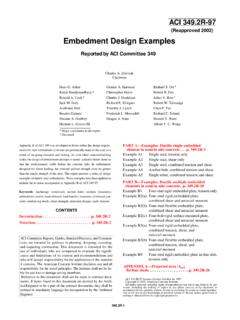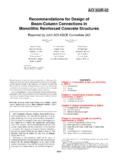Transcription of 503.6R-97 Guide for the Application of Epoxy and …
1 ACI became effective September 24, 1997. Copyright c O1998, American Concrete rights reserved including rights of reproduction and use in any form or by anymeans, including the making of copies by any photo process, or by electronic ormechanical device, printed, whitten, or oral, or recording for sound or visual repro-duction or for use in any knowledge or retrieval system or device, unless permission inwriting is obtained from the copyright proprietors. ACI Committee Reports, Guides, Standard Practices, andCommentaries are intended for guidance in planning, design-ing, executing, and inspecting construction. This documentis intended for the use of individuals who are competentto evaluate the significance and limitations of its contentand rec ommendati ons and who will accept responsibilityfor the Application of the material it contains.
2 The Amer ica nConcrete Institute disclaims any and all responsibility for thestated principles. The Institute shall not be liable for any lossor damage arising to this document shall not be made in contractdocuments. If items found in this document are desired byth e Architect/Engineer to be a part of the contract documents,they shall be restated in mandatory language for incorporationby the objective of this Guide is to provide information, requirements and pro-cedures necessary to achieve a bond between freshly mixed and hardenedconcretes by use of either Epoxy or latex : acrylics; adhesives; bonding; concrete evaluation; concretepreparation; Epoxy resins; latexes; styrene-butadiene; vinyl acetate poly-mers and 1 Scope, p. 2 Concrete evaluation, p.
3 3 Removal of unsound concrete,p. 4 Surface preparation, p. 5 Use of Epoxy adhesives, p. Selection of the Epoxy Mixing of the Epoxy Application of the Epoxy adhesiveChapter 6 Use of latex adhesives, p. Selection of latex Application of latex adhesivesChapter 7 References, p. Recommended Cited referencesGuide for the Application of Epoxy and Latex Adhesives for Bonding Freshly Mixedand Hardened ConcretesReported by ACI Committee 503 ACI * Members of the Committee who prepared this guidePeter MendisChairmanMyles A. MurraySecretaryMilton D. Anderson Robert W. Gaul Kelly M. PageCraig A. Ballinger St even H. Gebler Fred V. Palma, J. Bartholomew Richard L.
4 Glenn Raymond J. SchutzMichael C. Biesiada Paul R. Hollenbach Glenn W. SmoakRobert C. Cain Gregory Illig Joe SolomonFrank J. Constantino* Bert P. Kriekemans Michael M. SprinkelGlenn W. DePuy Joseph A. McElroy D. Gerry Walters*Floyd E. Dimmick, Sr. Shreerang Nabar Davis WhiteJack J. Fontana Rudi Olinga Richard MANUAL OF CONCRETE PRACTICECHAPTER 1 SCOPEThe objective of this Guide is to provide (primarily to con-tractors) information, requirements and procedures neces-sary to achieve a bond between freshly mixed and hardenedconcretes by use of either Epoxy or latex adhesives.
5 The re-quirements and procedures of this Guide consist of: Evaluation of the hardened concrete to determine theproper preparation and surface conditioning prior toapplication of adhesives, Selection of the most suitable Epoxy or latex adhesivedepending on the expected performance and environ-mental conditions (ACI ), and Application 2 HARDENED CONCRETE EVALUATIONC ontaminated and deteriorated concrete can be detectedby visual inspection; however, in many cases, visual deter-mination of the soundness of the concrete is not sufficient toselect the repair and preparation methods. It is necessary todetermine the extent of the deterioration, its cause, andwhether that cause is still active. Guidance on surveys forthese determinations may be obtained from ACI ,ACI , ACI and ASTM C methods for evaluating and determining con-crete condition include sounding with a hammer or chaindrag, ultrasonic pulse velocity, petrographic analysis, infra-red thermography, radar detection, core evaluation, mea-surement of chloride ion content, and bond tests such as thatdescribed in ACI and Appendix A of ACI preparation, as in Chapter 4, of any concrete to re-ceive an adhesive is of primary importance.
6 Bond failure atthe adhesive interface is likely if preparation is surface conditions are required with differenttypes of adhesive and are described in later 3 REMOVAL OF UNSOUND CONCRETEThe removal of the unsound or damaged concrete is a nec-essary part of rehabilitation work on structures involving theuse of an adhesive prior to placement of the freshly mixedconcrete. Such removal should be accomplished by well-controlled first step involves saw cutting the periphery of the re-quired removal area to a minimum of 1/4 in. (6 mm) in depth,consistent with the type of repair. This saw cutting delineatesthe repair area and serves to reduce edge spalling and weak-ness possibly introduced by outlining the area using othermethods. Also, it serves to give a shoulder against which therepair materials can be placed and finished.
7 It also results ina neater appearance. The saw-cut line should be located atleast 4 in. (100 mm) outside of the determined limits of thedefect to ensure that all defective concrete is removed andthat the fresh material is bonded to sound types of systems are available to remove unsoundconcrete (ACI 503R):a. Scabblers or bush hammers, that are tools with severalpoints that remove concrete by pulverizing or fracturing thesurface,b. Scarifiers, that have wheels with several points that aretipped with carbide, tungsten or diamonds. This equipmentremoves concrete by scraping or impacting the surface,c. Water blasting (hydrodemolition), which removes con-crete by projecting jets of potable water,d. Jackhammers, which remove concrete by impacting completion of removal of the concrete by one ormore of the above methods (Department of the Army, 1995),except for water blasting, all newly exposed surfaces shouldbe abrasive blasted and thoroughly washed down with a wa-ter jet with a minimum pressure of 1500 psi (10 MPa).
8 Thesurface is then blown off with dry, oil-free compressed air orvacuumed to remove any residual is recommended that the concrete is tested for pull-offstrength in accordance with the procedure described in Ap-pendix A of ACI 503R. If 250 psi ( MPa) is achieved, thenthe surface preparation and concrete quality is adequate. Ifthe pullout value is less than 250 psi ( MPa) and 90 per-cent failure occurs in the concrete at depth of 1/4 in. (6 mm)or greater, then the surface preparation is adequate, but theconcrete quality may not be adequate for the Application . Inthis case, an additional evaluation in accordance with Chap-ter 2 may be 4 SURFACE PREPARATIONT hose surfaces or parts of surfaces, which do not requireremoval of concrete, must be cleaned to remove all surfacecontaminants detrimental to the bond of the adhesive .
9 Suchcontaminants include, but are not limited to laitance, curingmembranes, surface coatings and treatments, oil, grease, ruststains, and following methods commonly used to remove suchcontaminants are:a. Shot blasting, which projects metal balls of varying sizeat high velocity to impact and abrade the surface,b. Abrasive blasting, which projects particles of varyingsize to impact and abrade the surface. The particles may becarried by air or water,c. Scabbling using bush hammers,d. Scarification,e. Water or more of these methods, alone or in combination,may be required for proper preparation. Guidance can be ob-tained from ASTM D 4258 and D of surface preparation method, the resultsshould be such that the surface is abraded to expose the ag-gregate in the surface with a maximum profile of 1/2 in.
10 (13mm), that is the depth between the lowest and highest pointsof the surface. It is recommended that the concrete is testedfor pull-off strength in accordance with the procedure de-scribed in Appendix A of ACI 503R. If 250 psi ( MPa) isachieved, then the surface preparation and concrete quality isadequate. If the pullout value is less than 250 psi ( MPa)and 90 percent failure occurs in the concrete at depth of 1/4in. (6 mm) or greater, then the surface preparation is ade-quate, but the concrete quality may not be adequate for theapplication. In some applications the design engineer mayincrease the required pullout FOR Epoxy AND LATEX ADHESIVESCHAPTER 5 USE OF Epoxy ADHESIVESTo ensure adequate bonding using Epoxy adhesives, thefollowing requirements should be met:a.
